OWC ThunderBay 4 mini with Thunderbolt 3
Support Manual

Introduction
1.1 System Requirements
Operating System
- Mac: macOS 10.13 or later
- PC: Windows 10 or later
Hardware
- Mac or PC with Thunderbolt 3 or later
Supported Drives
- 2.5-inch SATA drives
- Drive height up to 15mm
1.2 Package Contents
- (1) OWC ThunderBay 4 mini
- (1) Thunderbolt cable
- (1) Power cable
- (2) Security keys
- (1) 3 Years of SoftRAID Premium Access (License located on bottom of device)
1.3 Front View
A. Security Faceplate Lock – Use the included keys to lock or unlock the faceplate for access to the drive bays.
B. Drive Status LEDs - Power Only = Orange / Power & Data = Blue / Drive Activity = Flashing Green

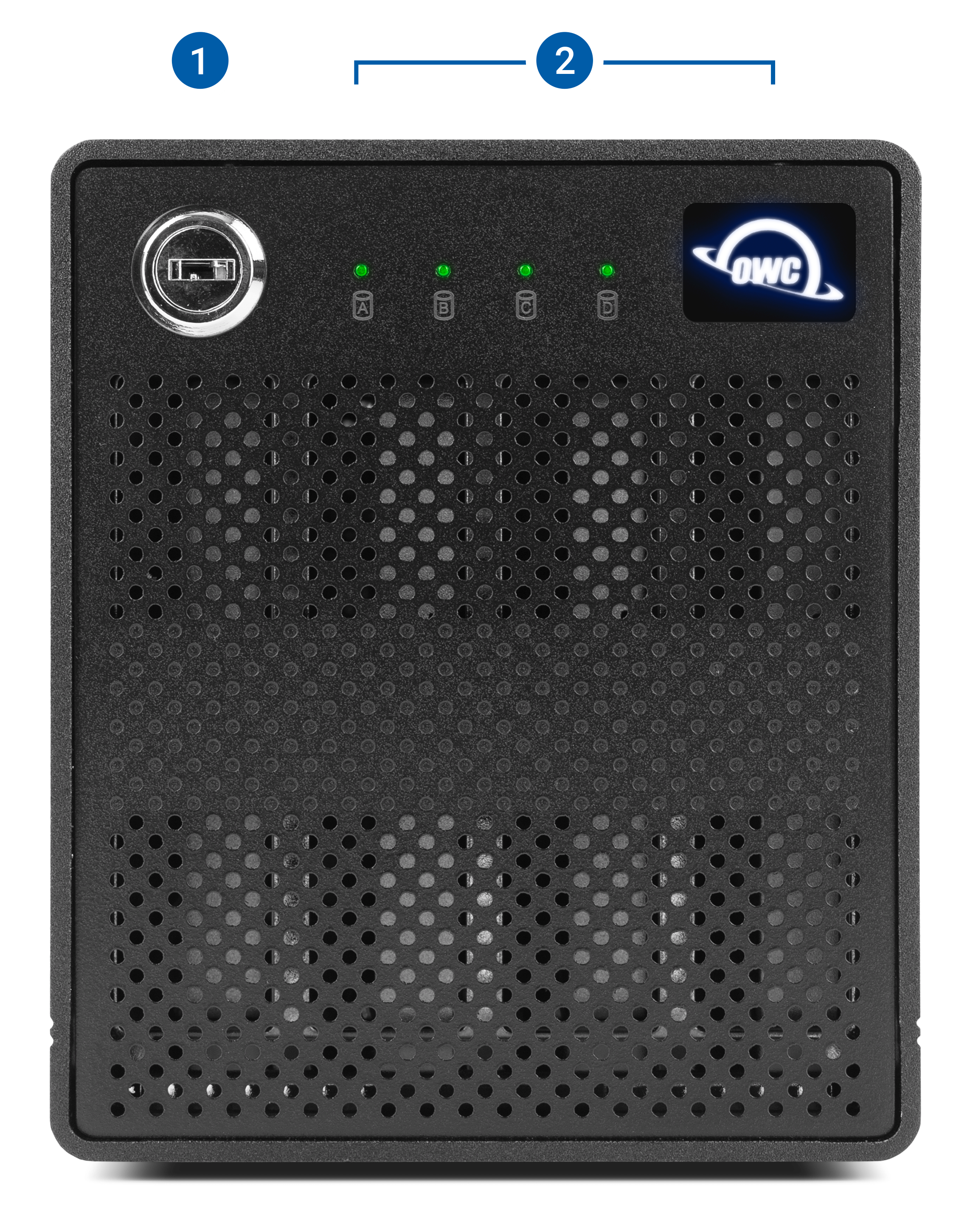
1.4 Rear View
1. Kensington Security slot – Attach a Kensington Security lock
2. Thunderbolt 3 ports – Connect to the computer host or chain additional Thunderbolt 3 devices
3. Power Port – Connect the power cable to power the device
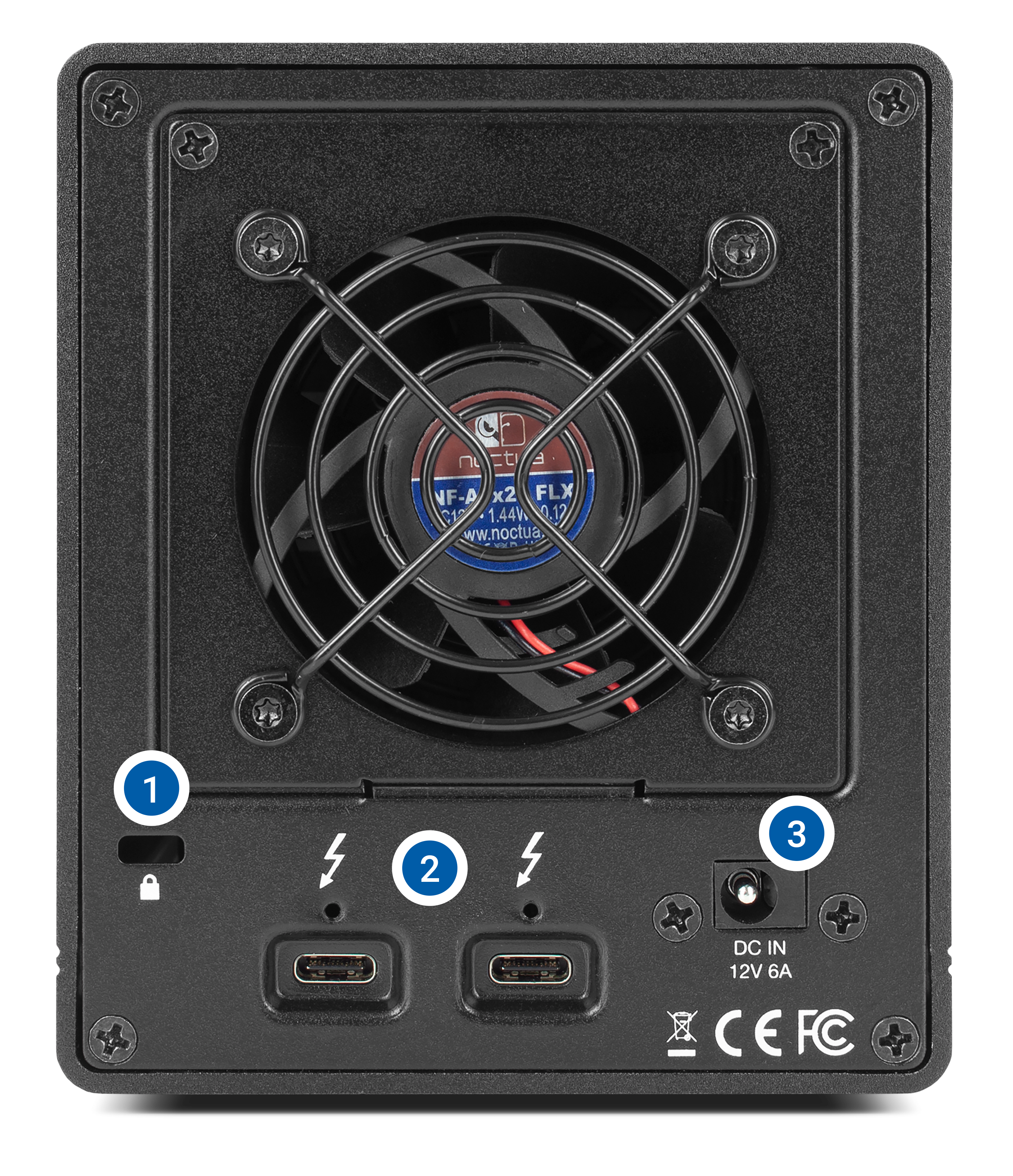
Getting Started
2.1 Device Setup
- This section describes the process of setting up the OWC ThunderBay 4 mini if purchased with pre-installed drives. The OWC ThunderBay 4 mini is available assembled with (8) SATA HDDs configured as an OWC SoftRAID RAID 5.
- Plug the power cable into the OWC ThunderBay 4 mini power port located on the back and into a power outlet.
- Connect the included Thunderbolt cable to the Thunderbolt 3 port located on the back of the OWC ThunderBay 4 mini and into a computer.
- The OWC ThunderBay 4 mini is configured as an OWC SoftRAID RAID 5. Downloading and installing the latest version of SoftRAID is recommended to experience the best performance.
- NOTE: OWC ThunderBay 4 mini devices come bundled with "3 Years of SoftRAID Premium Access". Please visit OWC SoftRAID Product Details for more information regarding SoftRAID and the bundled Premium Access.
- NOTE: The OWC SoftRAID license is located behind the Security Faceplate of the OWC ThunderBay 4 mini.
Mac OWC SoftRAID Setup
- Download OWC SoftRAID for Mac.
- Please review and follow the steps outlined in OWC SoftRAID Installation for Mac.
Windows OWC SoftRAID Setup
- If you are using the OWC ThunderBay 4 mini with the Windows operating system, the pre-installed drives need to be reconfigured before they can be used. The following options will allow the Mac formatted OWC ThunderBay 4 mini to work as a Windows formatted device.
- Download OWC SoftRAID for Windows
- Please review and follow the steps outlined in OWC SoftRAID Installation for Windows.
- Please consult the support article "Mac to Windows – SoftRAID Volume Conversation" for instructions to convert the Mac formatted OWC SoftRAID RAID 5 to a Windows formatted device through OWC SoftRAID.
- The Mac formatted OWC SoftRAID RAID 5 OWC ThunderBay 4 mini can be used in Windows through the purchase and installation of OWC MacDrive11 Pro. OWC MacDrive11 Pro allows access to software RAID Mac-formatted drives in Windows without performing a conversion process. Please visit OWC MacDrive Product Details or OWC MacDrive Support for more information.
- Download OWC SoftRAID for Windows
2.2 Assembly Steps
This section describes the process of installing drives into the OWC ThunderBay 4 mini if purchased as a bare enclosure.
1. Insert one of the keys into the lock on the top left of the security faceplate.
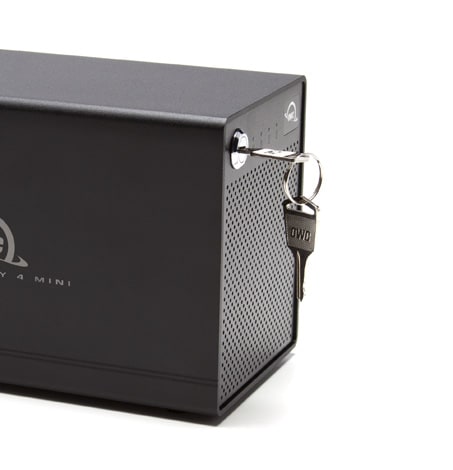
2. Turn the key clockwise, then pull it towards you. The faceplate will swing open.
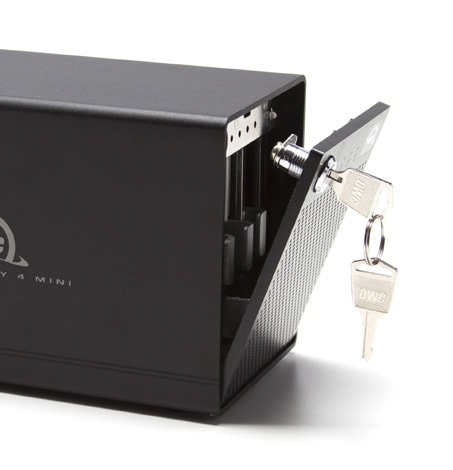
3. Pull up on the faceplate to remove it.
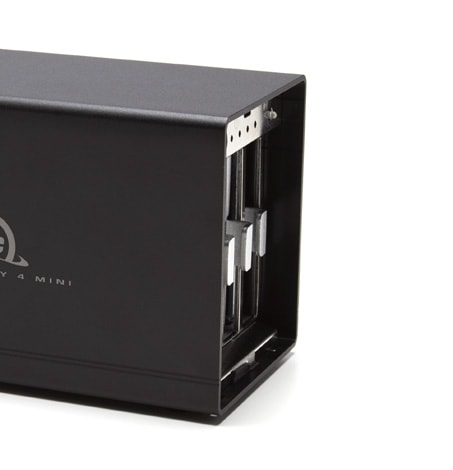
4. Pull on the tab at the center of an empty drive tray to remove the tray from the enclosure.
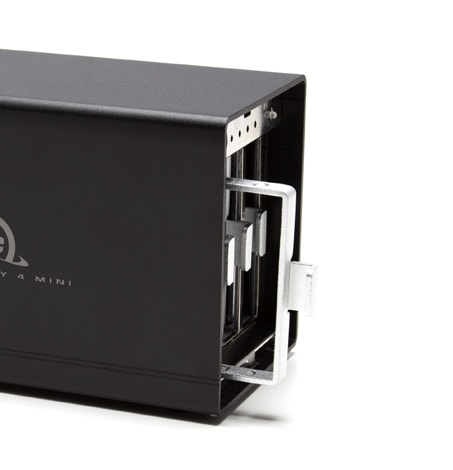
5. Set the drive tray as shown on your work surface. If you are replacing an existing hard drive, unscrew it from the drive tray at this time.
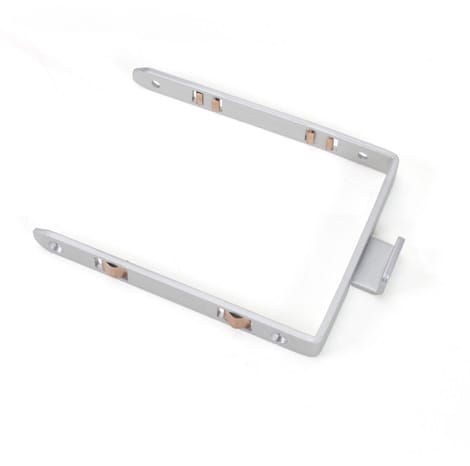
6. Place the hard drive inside the drive tray as shown. The label should face up and the SATA connectors should be on the far rear corner of the drive.
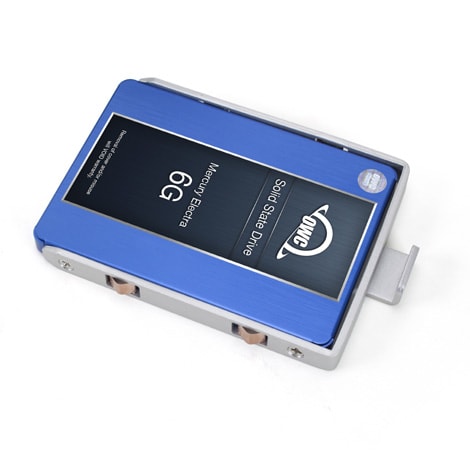
7. Fasten the drive into the drive tray using four of the included screws (two per side)
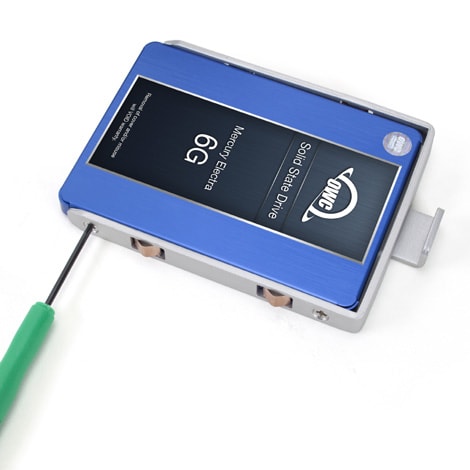
8. Slide the drive tray back into the rails in the ThunderBay 4 mini and push until it is seated fully, then push in on the thumbscrew and turn it clockwise until it stops turning. If you encounter resistance, do not force the drive tray. Remove it, check to make sure there are no obstructions and that the drive tray is lined up correctly, then slide it in again.
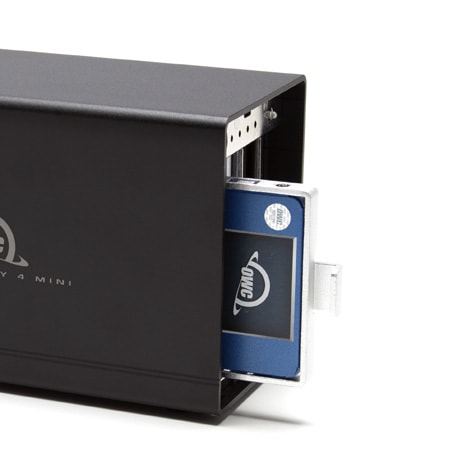
9. The installed drives are ready to be formatted. Move onto section 2.3 “RAID Configuration Options” for instructions on how to format and configure the OWC ThunderBay 4 mini.
2.3 RAID Configuration Options
OWC SoftRAID RAID Configuration
- Downloading and installing the latest version of OWC SoftRAID is recommended to experience the best performance from the OWC ThunderBay 4 mini.
- NOTE: OWC ThunderBay 4 mini devices come bundled with "3 Years of SoftRAID Premium Access". Please visit OWC SoftRAID Product Details for more information regarding SoftRAID and the bundled Premium Access.
- SoftRAID will assist with formatting the installed drives and setting up a RAID volume.
- NOTE: The OWC SoftRAID license is located on the bottom of the OWC ThunderBay 4 mini.
Mac OWC SoftRAID Setup
- Download OWC SoftRAID for Mac.
- Please review and follow the steps outlined in OWC SoftRAID Installation for Mac.
- Please review and follow the instructions outlined in Creating a macOS OWC SoftRAID Volume.
Windows OWC SoftRAID Setup
- Download OWC SoftRAID for Windows
- Please review and follow the steps outlined in OWC SoftRAID Installation for Windows.
- Please review and follow the instructions outlined in Creating a Windows OWC SoftRAID Volume.
Mac RAID Configurator
- Open the “Disk Utility” application on your Mac.
- Choose “File” and select “RAID Assistant”.
- Select a set type:
- Striped (RAID 0) set: A striped RAID set can speed up access to your data. You can’t create a RAID set on your startup disk; you must first start up your computer from another disk.
- Mirrored (RAID 1) set: Protect your data against hardware failure with a mirrored RAID set. When you create a mirrored RAID set, your data is written to multiple disks so the information is stored redundantly. You can’t create a RAID set on your startup disk; you must first start up your computer from another disk.
- Concatenated (JBOD) set: Increase storage space with a concatenated disk set. If you need one large disk, but you have several smaller disks, you can create a concatenated disk set to use as one large disk.
- Select the checkboxes of the disks you want to include in the set.
- For each disk, click the pop-up menu in the Role column and choose “RAID slice” or “Spare” to designate the disk as a standard member or spare in the set, then click Next.
- Enter a name for the RAID set in the RAID Name field.
- Click the Format pop-up menu, then choose a volume format that you want for all the disks in the set. (See File system formats available in Disk Utility.)
- Click the “Chunk size” pop-up menu, then choose a disk chunk size that you want used for all the disks.
- When you create a striped set, chunks of data from the same file are distributed across the drives. Ideally, you want data distributed across drives evenly and at an optimum size so that it can be efficiently accessed. If you want high data throughput from your set, choose a smaller chunk size so that data is spread across the drives and one drive can be accessing data while another is seeking the next chunk. With mirrored disk sets, choose a chunk size that matches the data you’re accessing. For example, when working with video files, your Mac is accessing large chunks of data, whereas when using a database of many small records, your disks may be accessing smaller chunks of information.
- If you are creating a mirrored RAID set, select the “Automatically rebuild” checkbox to allow the set to be automatically rebuilt when member disks are reconnected
- Click "Create" and then click "Done".
Device Management
3.1 Drive Failure
- If the OWC ThunderBay 4 mini was configured as a RAID 0, the data on the array is lost and the disk is no longer usable.
- If the OWC ThunderBay 4 mini was configured as a RAID 5, the RAID card will alert the user with a beeping tone. The RAID can continue to be used, but the drive should be replaced immediately.
3.2 Replacing Drives
- The Hot-Swap function can be used to rebuild disk drives in arrays with data redundancy such as RAID level 1, 3, 5, 6, 10, 30, 50 and 60. The data will remain accessible via the functioning drive until the array is rebuilt with a new drive.
- If the enclosure was purchased with drives and it is still under warranty, contact OWC technical support for assistance (see section 4.4 “Contacting Support”). If the unit is outside its warranty or was purchased without drives, follow the assembly instructions to access and replace the failed drive.
- NOTE: A failed drive must be replaced with an identical drive (model, capacity, firmware). Refer above to section 2.2 “Assembly Steps” for drive replacement steps.
- NOTE: The OWC ThunderBay 4 mini needs an active data signal to remain powered on. If it is disconnected from the computer, or if the computer goes to sleep or turns off, the device will power off. To minimize the rebuild time, it is recommended to keep the device connected to the computer (with the computer powered on), and disable any drive sleep settings on the computer for the duration of the rebuild.
- If the enclosure was purchased with drives and it is still under warranty, contact OWC technical support for assistance (see section 4.4 “Contacting Support”). If the unit is outside its warranty or was purchased without drives, follow the assembly instructions to access and replace the failed drive.
3.3 OWC Disk Performance
As of Windows 10 v. 1809 the default Disk Removal Policy is ‘Quick removal’ instead of ‘Better performance’.
NOTE: OWC storage solutions that are experiencing slow read/write speeds should consider checking and changing the Windows disk removal policy. Changing from "Quick removal" to "Better performance" can increase disk performance. OWC offers the application OWC Disk Performance to help change the Disk Removal Policy. Changing from "Quick removal" to "Better performance" can also be changed through OWC SoftRAID or manually through the operating system.
Please review the support article Storage Solutions: OWC Disk Performance for additional details.
3.4 Manually Unmounting Volumes
To ensure no data is lost during normal use, always eject or unmount the corresponding volume(s) from the operating system before powering off and disconnecting the device. Unmounting options are provided below.
macOS
- Drag the icon for the device you wish to unmount to the trash can; OR
- Right-click the device icon on the desktop, then click “Eject”; OR
- Highlight the device on your Desktop and press Command-E.
Windows
- Windows 10 build 1809 (October 2018) or later:
- Eject the drive by clicking the ‘Show hidden items’ menu in the Taskbar, then clicking ‘Safely Remove Hardware and Eject Media’, and last select the ‘Eject’ option for this volume.
- Windows 10 build 1803 and earlier:
- Go to the System Tray (located in the lower right corner of your screen). Click on the “Eject” icon (a small green arrow over a hardware image).
- A message will appear, detailing the devices that the “Eject” icon controls, i.e., “Safely remove...” Click on this prompt.
- You will then see a message that says, “Safe to Remove Hardware.” It is now safe to disconnect the device from the computer.
3.5 Usage Notes
- Thunderbolt device chains can support up to six Thunderbolt devices.
- Thunderbolt 2/Thunderbolt compatibility requires a certified Thunderbolt 3 (USB-C) to Thunderbolt 2 (mDP) adapter and a Thunderbolt 2 cable (not included). This configuration provides data transfer at up to 20Gb/s but does not support notebook charging.
- To ensure no data is lost during normal use, always eject or unmount the corresponding disk(s) from your operating system before powering off the device. Several options are provided below for Mac and PC.
Support Resources
4.1 Troubleshooting
- Begin your troubleshooting by verifying that the power cable is connected to the OWC ThunderBay 4 mini and to a power source. If the power cable is connected to a power strip, make sure that the power switch on the strip is turned on. Then, verify that both ends of your cables are properly plugged into the computer and the OWC ThunderBay 4 mini. If the OWC ThunderBay 4 mini is still not working properly, try connecting to another computer
- If the OWC ThunderBay 4 mini is still not working properly, try connecting to another computer or using another Thunderbolt cable. Remember that the OWC ThunderBay 4 mini needs an active data signal in order for the power to remain on. If it is disconnected from the computer, or if the computer goes to sleep or turns off, the OWC ThunderBay 4 will go to sleep.
- If you are still experiencing problems, OWC support is here to help. Please have your serial number ready which can be located on the bottom of your OWC ThunderBay 4 mini and printed on the original packaging. Please see section 4.4 "Contacting Support" for contact information.
4.2 About Data Backup
To ensure that your files are protected and to prevent data loss, we strongly suggest that you keep two copies of your data: one copy on your OWC ThunderBay 4 mini and a second copy on either your internal drive or another storage medium, such as an optical backup, or on another external storage unit. Any data loss or corruption while using the OWC ThunderBay 4 mini is the sole responsibility of the user, and under no circumstances may OWC, its parents, partners, affiliates, officers, employees, or agents be held liable for loss of the use of data including compensation of any kind or recovery of the data.
4.3 Online Resources
4.4 Contacting Support
4.5 About This Manual
The images and descriptions may vary slightly between this manual and the unit shipped. Functions and features may change depending on the firmware version. The latest product details and warranty information can be found on the product web page. OWC’s Limited Warranty is not transferable and
General Use Precautions
- To avoid damage, do not expose the device to temperatures outside the following ranges:
- Environmental (Operating)
- Temperature (ºF): 41º — 95º
- Temperature (ºC): 5º — 35º
- Environmental (Non-Operating)
- Temperature (ºF): -4º — 140º
- Temperature (ºC): -20º — 60º
- Environmental (Operating)
- Always unplug the device from the electrical outlet if there is a risk of lightning or if it will be unused for an extended period-of-time. Otherwise, there is an increased risk of electrical shock, short-circuiting, or fire.
- Protect your device from excessive exposure to dust during use or storage. Dust can build up inside the device, increasing the risk of electrical shock, short-circuiting, or fire.
- Do not block any ventilation openings on the device. These help to keep the device cool during operation. Blocking the ventilation openings may increase the risk of electrical shock, short-circuiting, or fire.
Safety Precautions
- Use proper anti-static precautions when handling this device. Failure to do so can increase the risk of electrical shock or short-circuiting.
- Never expose your device to rain, or use it near water, or in damp wet conditions. Never place objects containing liquids on the device, as they may spill everywhere and into the openings. This will increase the risk of electrical shock, short-circuiting, fire, or personal injury.
- To avoid any risk of electrical shock, short-circuiting, fire, or dangerous emissions, never insert any metallic object into the device.
- Please cease use of the device and contact OWC Support if it appears to be malfunctioning.
Terms & Conditions of Sale
Warranty
The OWC ThunderBay 4 mini has a 3 Year OWC Limited Warranty if it was bundled with drives. OWC ThunderBay 4 mini enclosures that do not ship with drives have a 1 Year OWC Limited Warranty. For up-to date product and warranty information, please visit OWC ThunderBay 4 mini Product Details.
Changes
The material in this document is for information purposes only and subject to change without notice. While reasonable efforts have been made in the preparation of this document to assure its accuracy, OWC, its parent, partners, affiliates, officers, employees, and agents assume no liability resulting from errors or omissions in this document, or from the use of the information contained herein. OWC reserves the right to make changes or revisions in the product design or the product manual without reservation and without obligation to notify any person of such revisions and changes.
FCC Statement
Warning! Modifications not authorized by the manufacturer may void the user’s authority to operate this device.
NOTE: This equipment has been tested and found to comply with the limits for a Class B digital device, pursuant to Part 15 of the FCC Rules. These limits are designed to provide reasonable protection against harmful interference in a residential installation. This equipment generates, uses and can radiate radio frequency energy and, if not installed and used in accordance with the instructions, may cause harmful interference to radio communications. However, there is no guarantee that interference will not occur in a particular installation. If this equipment does cause harmful interference with radio or television reception, which can be determined by turning the equipment off and on, the user is encouraged to try to correct the interference by one or more of the following measures:
- Reorient or relocate the receiving antenna.
- Increase the separation between the equipment and receiver.
- Connect the equipment to an outlet on a circuit different from that to which the receiver is connected.
Copyrights and Trademarks
© 2023 Other world Computing, Inc. All rights reserved. OWC, the OWC logo, and ThunderBay are trademarks of New Concepts Development Corporation, registered in the U.S. and/or other countries. Mac and macOS are trademarks of Apple Inc., registered in the U.S. and other countries. Thunderbolt and the Thunderbolt logo are trademarks of Intel Corporation in the U.S. and/or other countries. Other marks may be the trademark or registered trademark property of their owners.
No part of this publication may be reproduced, stored in a retrieval system, or transmitted in any form or by any means, electronic, mechanical, photocopying, recording or otherwise, without the prior written consent of OWC.
Free Support Chat
Our free award-winning support team is ready to answer all of your questions. Technical support is available Monday - Friday: 9AM - 6PM. Customer Support & Sales is available Monday - Friday: 9AM - 6PM. Support is unavailable on U.S. Federal holidays. Talk to a human today.

 1-800-275-4576
1-800-275-4576